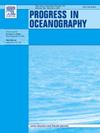A first look at xenophyophores (Rhizaria, Foraminifera) in the lower bathyal Bering Sea and abyssal areas adjacent to the Aleutian Trench
IF 3.8
3区 地球科学
Q1 OCEANOGRAPHY
引用次数: 0
Abstract
Xenophyophores are an abundant component of the megafauna in parts of the equatorial and temperate North Pacific, but few records exist of these giant agglutinated foraminifera in northern North Pacific and adjacent waters. Here, we present a preliminary survey of xenophyophores from the bathyal Bering Sea (∼3500 m depth) and at abyssal depths (4294–6555 m) adjacent to the Aleutian Trench, based on collected material, mainly fragments, and seafloor images. The dominant xenophyophore in the Bering Sea is a reticulated form that yielded DNA sequences identical to those obtained from Syringammina limosa, a species described from > 2700 km to the west in the Sea of Okhotsk. Also visible in seafloor photographs were various plate-like forms, often with upturned, undulating rims, but also branching plates and other more complicated morphotypes that probably represent distinct species. At stations close to the Aleutian Trench, core and epibenthic sledge samples yielded xenophyophores at seven of the 16 sampling sites. At least eleven morphospecies were recognised among those collected, none of which resembled S. limosa or the plate-like Bering Sea forms. Seafloor images revealed 16 fairly distinct domed or plate-like morphotypes three of these are possibly represented among the collected specimens, making a total of around 24 morphotypes or morphospecies. A few images show morphotypes similar to those seen in the Bering Sea. Our results suggests that xenophyophores are as diverse in the northern North Pacific as they are elsewhere in the Pacific Ocean.
首先看看白令海下部深海和阿留申海沟附近深海地区的异形藻(根茎属,有孔虫目)
在赤道和温带北太平洋的部分地区,异形虫是巨型动物的一个丰富组成部分,但在北太平洋北部和邻近水域很少有这些巨型粘连有孔虫的记录。在这里,我们根据收集到的材料,主要是碎片和海底图像,对白令海(~ 3500 m深度)和阿留申海沟附近深海(4294-6555 m)的xenophyophys进行了初步调查。白令海的主要外生植物是一种网状形式,其DNA序列与从Syringammina limosa中获得的DNA序列相同,Syringammina limosa是一种来自>;向西2700公里在鄂霍次克海。在海底照片中还可以看到各种各样的板块形状,通常有向上的起伏的边缘,但也有分支板块和其他更复杂的形态,可能代表不同的物种。在阿留申海沟附近的站点,在16个采样点中有7个取样点的岩心和底栖动物雪橇样品产生了外叶藻。在收集到的标本中,至少有11种形态被识别出来,没有一种与S. limosa或板状白令海形态相似。海底图像显示了16种相当不同的圆顶或板状形态,其中3种可能在收集的标本中有代表,总共约有24种形态或形态种。一些图像显示的形态与在白令海中看到的相似。我们的研究结果表明,在北太平洋北部和太平洋其他地方一样,植藻种类繁多。
本文章由计算机程序翻译,如有差异,请以英文原文为准。
求助全文
约1分钟内获得全文
求助全文
来源期刊

Progress in Oceanography
地学-海洋学
CiteScore
7.20
自引率
4.90%
发文量
138
审稿时长
3 months
期刊介绍:
Progress in Oceanography publishes the longer, more comprehensive papers that most oceanographers feel are necessary, on occasion, to do justice to their work. Contributions are generally either a review of an aspect of oceanography or a treatise on an expanding oceanographic subject. The articles cover the entire spectrum of disciplines within the science of oceanography. Occasionally volumes are devoted to collections of papers and conference proceedings of exceptional interest. Essential reading for all oceanographers.
 求助内容:
求助内容: 应助结果提醒方式:
应助结果提醒方式:


